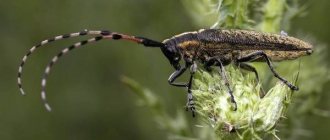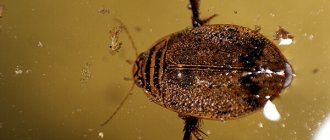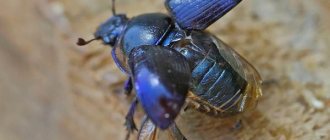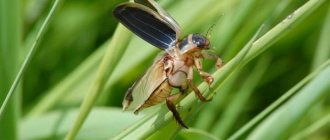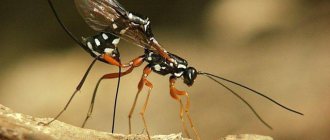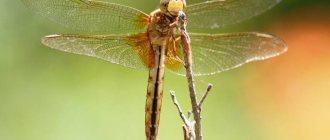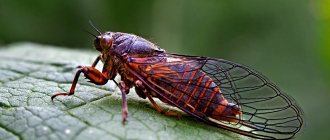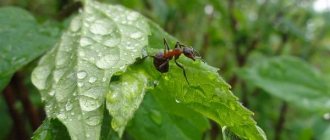- A beetle similar to a cockchafer
Khrushchev's cherry pond is humming over the cherries. T. Shevchenko.
Familiar to many from the imperishable poetry of Taras Shevchenko, the Khrushchev, also known as the May beetle, is especially well known to gardeners and gardeners, and not from the best side, since it is one of the most dangerous agricultural pests. This insect got its name due to its habit of appearing in the spring and beginning its active activity in May. What are the habits of the cockchafer, what is its appearance, how to fight it, read about all this below.
Description, structure, characteristics
What does a cockchafer look like? The May beetle is an arthropod insect and belongs to the order Coleoptera, the family Platinaceae, and the genus of May beetles.
As for insects, the cockchafer is quite large, some individuals reach 17.5-31.5 mm in length. The body of the Khrushchev is wide and convex, elongated oval in shape, with a black or red-brown color. Also, the body of the cockchafer is protected by a chitinous shell; it itself consists of a head, chest and abdomen. In turn, the insect’s thorax consists of three segments, and the abdomen of eight.
The wings of the cockchafer are protected by rear elytra of a reddish-brown or yellow-brown color. The beetle's head is small and retracted into the elytra; it is dark in color, although there are beetles with a greenish tint on the head.
The cockchafer is also a very hairy creature; it is almost completely covered with hairs of different lengths, thicknesses and colors. Typically, the colors of the cockchafer's hair are white, yellow or gray, and, interestingly, in some beetles the vegetation can be so dense that it even hides the main color.
The longest hairs, collected in longitudinal stripes, adorn the head of the cockchafer. The elytra have long, single protruding hairs, while the chest is strewn with yellow hairs.
The beetle's abdomen, consisting of eight segments, also has small openings - spiracles, which play an important role in the life of the insect; it is through them that air enters the respiratory tubes, trachea and is distributed throughout the beetle's body.
The cockchafer has three pairs of jointed limbs, which also have hairs, especially long on the thighs. The first pair of beetle legs comes from the anterior thorax, the second pair from the mesothorax, and the third from the metathorax. The tibiae of the front legs have 2-3 teeth.
The eyes of the cockchafer are convex, they have a complex structure (each complex eye consists of several thousand simple ocelli), and allows them to see at a wide viewing angle.
The antennae of the cockchafer perform an important olfactory function for the insect; they consist of ten segments, with the third segment being the longest. The flagella of the antennae are strongly curved; in general, they somewhat resemble a club or a fan. In males, such a “mace” is more curved and larger in size than in females.
As for the oral apparatus, cockchafers have a gnawing type, thanks to which they easily eat plant shoots. Along the edges of the mouth there are three pairs of oral appendages: the first of them is the stingers, the second is the lower jaw, and the third forms the lower lip. The upper lip, which is a small plate, covers the movable oral appendages from above. When eating, the beetle uses both the lower and upper jaws, and uses the palps to move food closer to the mouth.
The chitinous shield of the cockchafer has a semi-oval shape, it is large, smooth and glossy.
The structure of the head of a Khrushchev
The beetle's head has a mouth opening with an upper lip that looks like a transverse plate. The mandibles and lower lip have palps, which are sensory organs.
There are eyes on both sides of the head. The structure of the organ of vision is complex: it consists of a huge number of simple eyes. The beetle's antennae with plates are an organ of smell; with their help, the beetle finds food. The male has a strongly curved “club” at the end of the antennae. The insect's head is unable to turn from side to side.
Habitats
May beetles live over a wide geographic range: in Europe, Asia, North America and even on some islands of Oceania. Of course, they exist in Ukraine as well. One way or another, most species of cockchafers live in a temperate climate zone, although there are species living in the hot tropics.
As habitats, beetles, also known as beetles, prefer wooded areas, near rivers, where there is not only food, but also loose sand and soil. But in places with clay soil there are no cockchafers, for the reason that their females simply cannot dig a tunnel and lay eggs in such soil.
What are the harms and benefits of Khrushchev?
Maliciousness
Why is the cockchafer dangerous?
The larvae spoil the roots of various plants, especially damaging young seedlings. Adults actively eat leaves. It is known that large populations can completely destroy a woodland or garden .
Fortunately, effective methods have now been developed to combat the cockchafer.
Benefit
Some sources claim that the cockchafer has healing qualities . It helps cure impotence, pulmonary tuberculosis, uterine cancer, scrofula and radiculitis.
Lifestyle
In the spring, when green leaves begin to bloom on the trees, male cockchafers appear. After 7-10 days, females join them. Many species of cockchafers are especially active at night and in the evening. Some beetles fly actively even in the morning hours before dawn; sometimes they are attracted to artificial light sources. But during the day, especially after eating, the beetles, on the contrary, slow down their activity.
During its short terrestrial life of 30-40 days, the cockchafer nevertheless actively flies; in search of food, it can fly up to 20 km in a day, developing a speed of 8-11 km per hour. During the flight, the Khrushchevs buzz loudly; it is this feature that was aptly noted by the great Ukrainian poet T. Shevchenko.
Features of character and lifestyle
Photo: Large cockchafer
Khrushchi are disciplined animals that lead an orderly lifestyle. Almost every species has its own year of mass summer. And this routine rarely changes. Thus, Nigripes beetles migrate once every four years. We are talking about a massive summer. That is, between these four years, representatives of Nigripes can be found in small numbers.
The main activity of cockchafers is searching for food. This is exactly what these insects do immediately after their birth. Adults fly to search for leaves, larvae absorb the root system of trees and plants underground. This is exactly how almost the entire life of an insect goes.
May beetles are distinguished by great determination. But there is a factor that takes them out of the usual rhythm of life. Only blue color can slightly stop the activity of the beetle. Therefore, in clear weather the animal does not show its activity.
May Khrushchev is a real disaster for agriculture. Periodically, people carried out mass destruction of beetles when their population exceeded permissible limits. So, in 1968, more than fifteen million beetles were destroyed at one time in Saxony. If today we allow the number of beetles to increase to such a figure, then a global catastrophe will occur in the agricultural industry.
The character of the May Khrushchev is peaceful. This insect tries to avoid human society. It is very purposeful and spends the entire day searching for and digesting food. The cockchafer does not enter into battles with other insects or animals. Leads a calm, measured lifestyle.
Types, photos and names
To date, zoologists know 63 species of cockchafers; below we will describe the most interesting of them.
Eastern May Khrushchev
He is also the eastern May beetle, he is also the wild chestnut beetle. This species is characterized by pronounced sexual dimorphism; females are significantly smaller than males: 20-29 mm long in males versus 10-15 mm in females. It has a variable color, although in general brownish and red colors predominate. Also distinguished by its black antennae. The Oriental cockchafer is very numerous in Europe and Asia.
Western May Khrushchev
Also known as the Western cockchafer. It is longer in size than its eastern relative, with a strongly convex body. They are almost the same in size, but differ in some habits and details of appearance, for example, the Western Khrushchev in the spring appears 10 days later than the Eastern one, it is more thermophilic and likes to settle in fields. His antennae are not black, but light brown or reddish-brown. Lives in many European countries. In Ukraine, many beetles of this species live in the Odessa and Kherson regions, in the lower reaches of the Dniester.
Caucasian May Khrushchev
It is a representative of a rare species of May beetles. Currently it lives exclusively in the southwestern part of Germany and Austria. It differs from other species in having a short, more rounded pygidium. They also have whitish scales on the elytra, which sometimes almost completely hide their main color.
flowers
Heat-loving cockchafers that do not travel far to the north. In the CIS, their range extends across Belarus, Ukraine and the southern regions of Russia. There are varieties:
- large flower flower (Hoplia philanthus);
- small flower flower (Hoplia parvula);
- golden hoplia (Hoplia aureola);
Like all beetles, adult flower beetles damage the above-ground parts of plants. The larvae feed on living roots.
Large flower bloom
A medium-sized beetle, black or black-brown in color. The color of the elytra varies from dark to red-brown. The color of the elytra can also be dark with a red-brown border. On the upper side of the body the main color is partially covered by gray scales. The 10-membered antennae are black-brown. The body is slightly convex, oblong. Length 7-9 mm.
The range includes the territory of the entire European part of Eurasia. Summer begins in May. The lifespan of the imago is no more than 3 months. The general life cycle is 1 year. The females die after laying their eggs, and the larvae go to winter. Beetles are active during the daytime.
Lesser flowerflower
A small green beetle up to 1 cm in size. In fact, the color of the small flower beetle is black, but the body is covered with matte or shiny scales of green, golden-green, blue-green or brown.
On a note!
Sometimes green scales can be mixed with brown ones. Because of this feature, the beetle can easily be confused with a young bronze beetle or mint leaf beetle. But light hairs on the pronotum, sticking out between the scales, help to distinguish insects. They give the impression of a white coating. The underside of the body is covered with silvery-white scales.
The range includes Eastern Europe and reaches the middle reaches of the Urals. Absent in the Caucasus and Crimea.
Summers from late May to September. Active during the day, feeding on leaves. The larvae of this species do not have eyes. Beetles are found in large numbers on sandy soils. The life cycle is annual. The larvae go to winter.
flowers
Golden hoplia
A small beetle measuring 7-8 mm. The color is black, but the beetle is covered with yellowish-green scales with a spotted pattern. Black and brown spots. Females are larger than males. They don't fly well. The maximum distance is 200 m. The summer begins at the end of May and ends in August. The bulk of beetles emerge in June–July. Habitat: meadows. Settles in sandy and sandy loam soils. The range of golden hoplia is Eastern Siberia.
The rest of the hopliyas live outside the territory of the CIS and are not of particular interest.
Reproduction and development. Life cycle.
Development with complete transformation is typical for this insect. The life cycle of Khrushchev lasts from three to five years and includes the following stages:
The breeding season for beetles occurs at the end of May; after mating, the female buries herself in the ground, lays a clutch of eggs there (usually 20-30 eggs in one clutch), then mates again and lays a clutch again. During her short adult life, a female cockchafer manages to make 3-4 clutches.
This is what chafer eggs look like; they are from 1.5 to 2.5 mm in diameter. After 30-40 days, the larvae hatch from them. The larvae of the cockchafer have a thick, curved body with three pairs of limbs and a large, round head. The larva lives and winters in the ground for 3-4 years, during the winter cold, burrowing to a depth of 1-1.5 meters, and rising higher with the onset of spring.
If in the first year it feeds on humus and grass roots, then in the second year it begins to eat the thicker roots of plants, thereby causing great harm. In search of food, beetle larvae crawl up to 30 cm.
Then, after the third or fourth wintering, closer to autumn, the larvae pupate. During this period, the larva burrows deeper into the ground and turns into a pupa, being in a special chamber - the pupal cradle. Gradually she begins to resemble an adult. The pupal phase lasts 30-45 days; at the end of this period, an adult cockchafer emerges from the pupa, which remains in its pupal cradle for some time and only at the end of April, beginning of May begins to emerge to the surface, with females emerging for 7-10 days later than males.
Nutrition
Enough has already been said about the appetite of these insects, as well as about the fact that beetles are attracted to an exclusively plant-based menu. It's time to talk about taste preferences.
May beetles can be considered gourmets, because they especially love to feast on fresh shoots and young greens. As a result, wild plants and cultivated plants suffer. Of the latter, especially favorite ones are: apple tree, plum tree, sweet cherry, cherry.
However, since beetles are practically omnivorous in terms of their plant diet, all the gardener’s values can suffer from their gluttony: currants, gooseberries, sea buckthorn and others.
Of the forest trees that are in danger: birch, oak, aspen, poplar and others, others, others, as well as rarer ones: hazel, chestnut and others. More specifically, feeding habits largely depend on the type of beetle, as well as on its habitat and the representatives of the flora that grow there.
Khrushchev destroy a variety of parts of plants: ovaries, flowers, leaves, roots. Whether it is woody food, shrubs or grass is largely determined by the stage of development of these voracious creatures.
For example, a cockchafer larva , which begins its life activity in the soil, does not have much destructive power in the first year of its existence. She eats grass rhizomes and humus.
But after a year, it already feeds on the roots of forest trees, berries and fruit crops. In the same way, significant damage is caused to strawberries, potatoes, carrots and others. Adult beetles, existing in the aboveground world, prefer the upper parts of shrubs and woody flora. How it all ends is already known.
Fighting the cockchafer
At all stages of its existence, the cockchafer is a dangerous pest for agricultural crops; beetle larvae eat the roots of plants, causing drying and death of the latter; adult individuals damage vegetation by eating leaves and shoots. For this reason, to effectively combat them, comprehensive measures are needed, aimed at both the destruction of larvae and adults. The most effective against them are special insecticides:
- Bazudin is a combined remedy against cockchafers; it kills them immediately after cultivating the soil.
- Anti-Khrushchev - the advantage of this insecticide, in addition to its effectiveness against Khrushchev, is also low toxicity.
- Zemlin is an effective remedy against cockchafer larvae; it is introduced into the ground along with planting material.
The fight against cockchafers with folk remedies also takes place, for this you need:
- Do regular digging of the earth and remove the larvae by hand.
- Conduct autumn digging with the addition of Bleach or bleach to the soil.
- Treat the soil and foliage of fruit trees with an infusion of onion peels.
- Plant white creeping clover in the garden; its roots, which accumulate nitrogen, can repel insects.
- Get birdhouses: starlings, thrushes and other birds will happily eat cockchafers in your area.
- Moles and hedgehogs can also be your allies in the fight against these harmful insects, so if you find a mole hole in your area, do not rush to bury it, just as you should not scare away hedgehogs from the garden.
Circulatory system
Like other arthropods, this insect has an open circulatory system. With the flow of blood in the body cavity, internal organs and tissues receive nutrients. The movement of blood is provided by the heart, which pulsates and drives it to the head end of the body. Its reverse flow is impossible due to the heart valves. When the heart expands, blood enters it from the back of the body. The side openings of the central organ of the circulatory system have valves that prevent the reverse flow of blood. This biological fluid does not participate in the respiratory process.
Interesting Facts
- The most mysterious and surprising thing is their ability to fly; the fact is that, according to the laws of aerodynamics, they simply should not fly. Nevertheless, beetles fly contrary to all aerodynamic laws; perhaps in the future zoologists and technicians will be able to penetrate the secret of the flight of these insects.
- May beetles are unusually very purposeful creatures; having set a goal, he will go to it no matter what.
- In Anderson's fairy tale "Thumbelina", the cockchafer was one of the contenders for Thumbelina's hand and heart.
Fighting and natural enemies
Some species of birds, as well as the badger, hedgehog, and mole, are natural enemies of the cockchafer. Their diet often includes similar insects.
In order to protect your own garden from pest attacks, it is recommended to use insecticidal preparations such as bazodin, antikhrusch, zemlyan and others.
Links and useful literature on the topic
- Johan Christian Fabricius. Systema entomologiae sistens insectorum classes, ordines genera, species, adjectis synonymis, locis, descriptionibus, observationibus. - Flensburg, Lipsia, 1775. - P. 31.
- May bug // Encyclopedic Dictionary of Brockhaus and Efron: in 86 volumes (82 volumes and 4 additional). - St. Petersburg, 1890-1907.
- Medvedev S.I. Scarabaeidae // Key to insects of the European part of the USSR (edited by G. Bey-Bienko.) - Moscow-Leningrad, 1965
- Barton, K. Verfluchte Kreaturen: Lichtenbergs "Proben seltsamen Aberglaubens" und die Logik der Hexen- und Insektenverfolgung im "Malleus Maleficarum", in Joost, U.; Neumann, A. (eds): Lichtenberg-Jahrbuch 2004, p. 11ff, Saarbrücken 2004 (SDV Saarländische Druckerei und Verlag), ISBN 3-930843-87-0. online.
Author: Pavel Chaika, editor-in-chief of Poznavaika magazine
When writing the article, I tried to make it as interesting, useful and high-quality as possible. I would be grateful for any feedback and constructive criticism in the form of comments on the article. You can also write your wish/question/suggestion to my email [email protected] or Facebook, with respect, the author.
Author page
This article is available in English -
June Bug (Cockchafer, May Beetle, Chafer Beetle).
How long do beetles live?
As a rule, this insect lives in the adult stage for about a couple of months. The peculiarity is that males always die almost immediately after the completion of the process of fertilization of females. The females, after laying their eggs deep in the ground, also die.
It is generally accepted that there are four stages of development of any cockchafer: from egg to adult, there are two more stages: the larva, which was discussed above, and the pupa. In total, insects live no more than four years.
